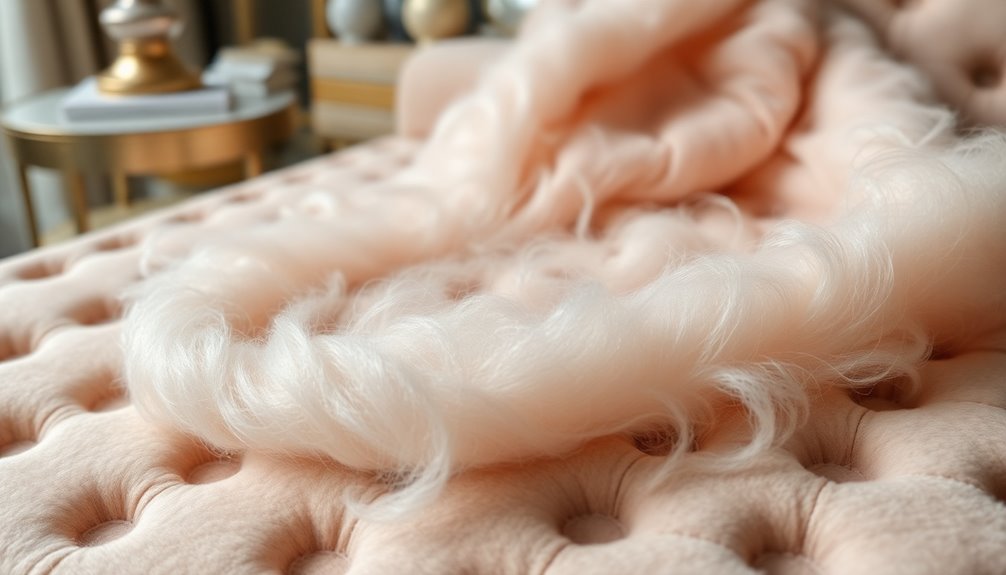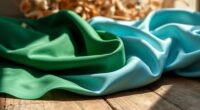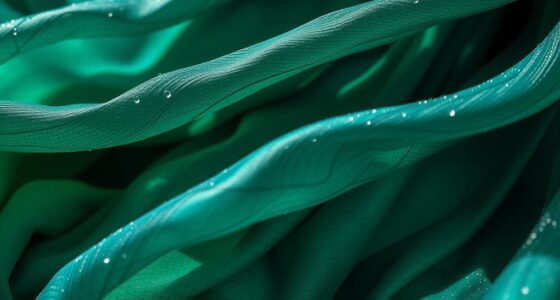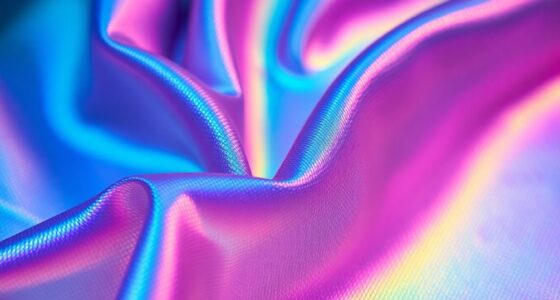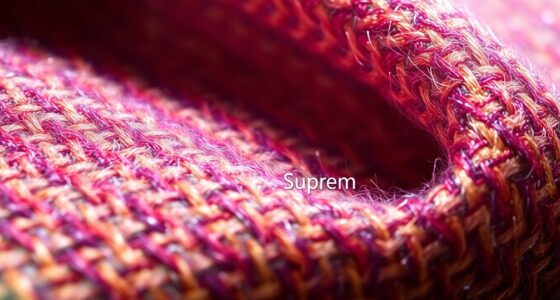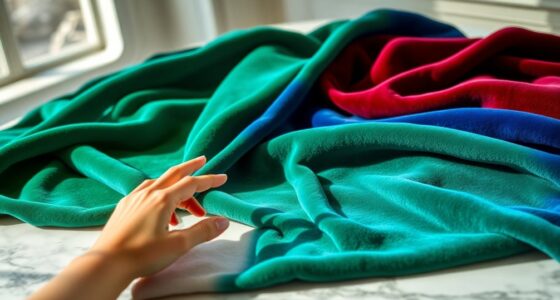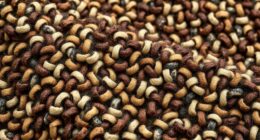Mohair is a luxurious fabric sourced from the fleece of Angora goats. Known for its remarkable softness, it rivals cashmere while offering superior durability and breathability. With a unique sheen and coarser texture, mohair creates stunning garments that maintain warmth in winter and keep you cool in summer. This versatile fiber is often used in high-end fashion. Explore its rich history and sustainable practices, and you'll discover even more about this exquisite material.
Key Takeaways
- Mohair is a luxurious fiber derived from Angora goat fleece, known for its durability and soft texture.
- It has a coarser texture than cashmere but offers unique luster and breathability for year-round wear.
- Mohair fibers range from 25 to 40 microns, providing a silky feel with excellent temperature regulation.
- The production process involves careful shearing, sorting, and washing to maintain high quality and luxury.
- Sustainable farming practices prioritize animal welfare and support a circular economy in mohair production.
Understanding Mohair: An Overview

Mohair, often hailed as the "diamond fiber," is a luxurious fabric that captures attention with its stunning sheen and remarkable durability.
Derived from the fleece of Angora goats, mohair boasts a fiber diameter ranging from 25 to 40 microns, making it coarser than cashmere but still incredibly soft to the touch.
This unique softness, combined with excellent breathability, guarantees that mohair keeps you warm in winter while remaining light and cool in summer.
It's no wonder that mohair is a favorite in high-end fashion, often featured in exquisite sweaters and scarves.
When it comes to quality, the meticulous production process—shearing Angora goats twice a year—guarantees that every strand of mohair maintains its luxurious qualities.
The Origin of Mohair: Where Does It Come From?
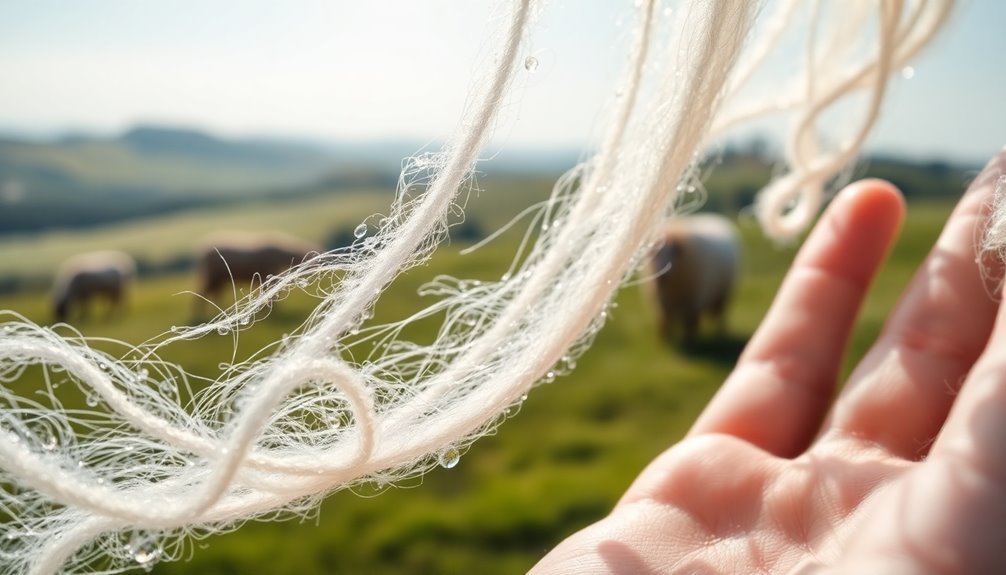
When you think about mohair, it's fascinating to know it comes from the fleece of Angora goats, primarily raised in regions like the U.S. and Turkey.
This luxurious fabric has a rich history, dating back to its introduction in European markets during the 16th century.
Understanding its origins helps you appreciate the craftsmanship and global effort behind each exquisite piece of mohair.
Angora Goat Source
The luxurious fabric known as mohair comes from the fleece of Angora goats, primarily raised in regions like South Africa, Turkey, the U.S., and parts of Europe.
These goats are sheared twice a year, providing you with high-quality natural fibers that boast a strength and sheen unlike any other.
The unique fleece consists of long, silky fibers that range from 25 to 40 microns in diameter, making mohair thicker than cashmere while still offering that soft touch you desire.
The production process is meticulous; it involves shearing, sorting, washing, and combing to guarantee you receive a fabric with a truly luxurious feel.
When you choose mohair, you're embracing an exquisite blend of comfort and elegance.
Global Production Regions
Among the various luxurious fabrics, mohair stands out due to its unique origins. This exquisite fiber is primarily sourced from Angora goats, which thrive in specific climates found in South Africa, the United States, Turkey, and parts of Europe.
South Africa is the leading producer, contributing about 50% of the world's mohair supply. These goats are sheared twice a year, yielding a significant amount of fiber that supports a robust global market.
Farmers often adopt sustainable practices to guarantee both the health of the Angora goats and the land they graze on. This commitment to sustainability is essential, as it helps maintain the luxurious qualities that make mohair so highly sought after in the textile industry.
Historical Significance and Use
Originating from the fleece of Angora goats, mohair has a rich history that dates back thousands of years. This luxurious fabric has been woven into the cultural fabric of ancient civilizations, like the Roman and Ottoman Empires, where it was cherished for its sheen and durability. The term "mohair" itself comes from the Arabic word "mukhayyar," highlighting its historical significance.
| Civilization | Use of Mohair | Significance |
|---|---|---|
| Roman Empire | Clothing and textiles | Prized luxury |
| Ottoman Empire | Decorative fabrics | Symbol of status |
| Modern Fashion | High-end garments | "Diamond fiber" |
Today, mohair continues to be a sought-after choice, celebrated for its unique fibers and lasting appeal.
Characteristics of Mohair: What Makes It Unique?
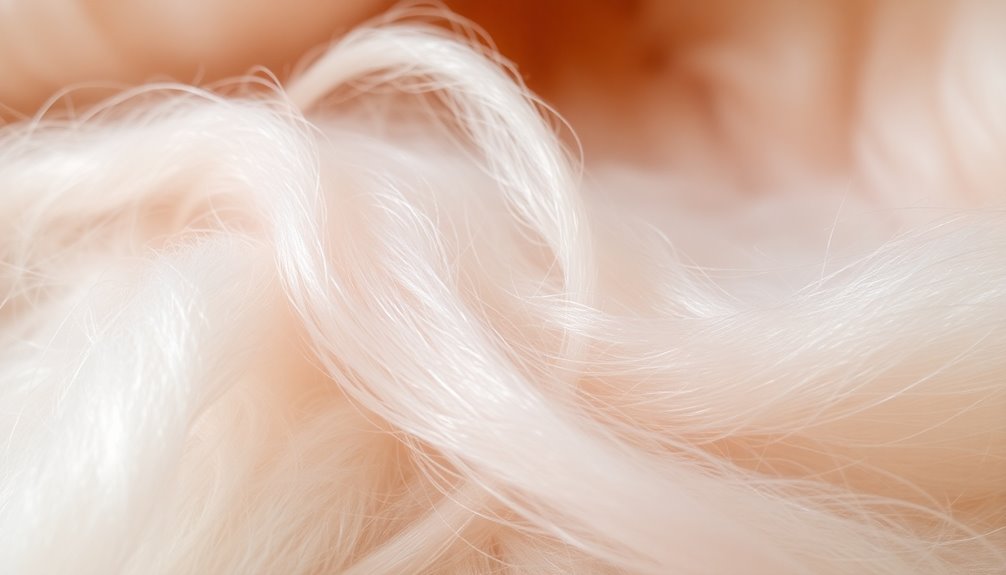
Mohair stands out in the world of textiles for its unique combination of luster and durability. Derived from the fleece of Angora goats, this luxurious fabric is known for its softness and silky feel, making it visually appealing.
With a fiber diameter ranging from 25 to 40 microns, mohair offers a coarser texture than cashmere, yet still maintains an exquisite touch. Its hollow fibers provide excellent breathability, keeping you warm in winter and cool in summer.
Plus, mohair is incredibly durable, resistant to wear, stretching, and shrinking, ensuring your garments last. Often referred to as the "diamond fiber," its natural sheen and strength solidify mohair's position as a sought-after choice in high-end fashion and textiles.
Mohair Vs Cashmere: a Comparative Analysis
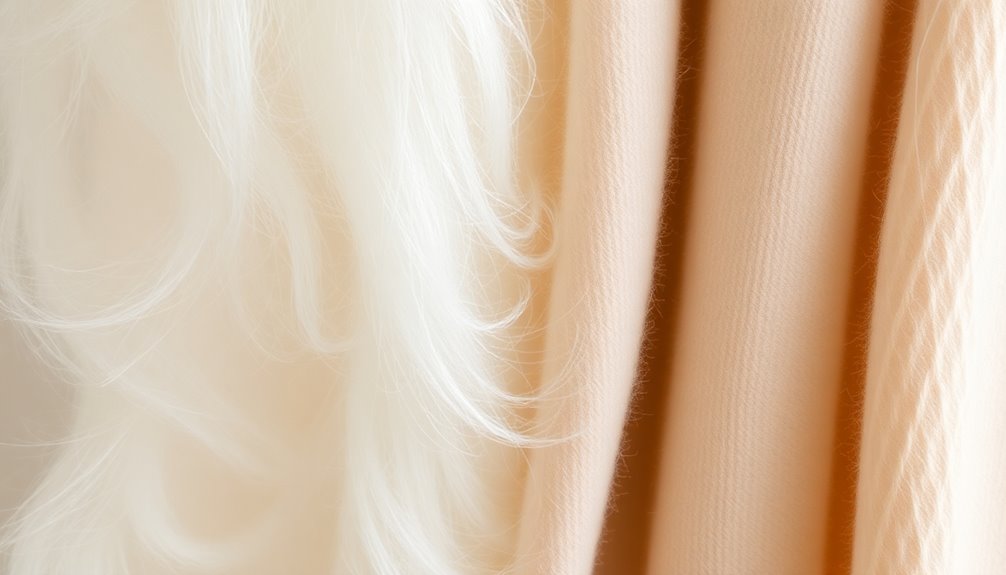
When comparing mohair and cashmere, you'll notice distinct differences in softness and texture.
While cashmere offers incredible warmth and a silky feel, mohair stands out with its durability and sheen.
Understanding these factors can help you choose the right fiber for your needs.
Softness and Texture Comparison
Softness and texture play essential roles in distinguishing luxury fabrics, particularly when comparing mohair and cashmere.
Cashmere fibers, with a diameter of 12-16 microns, are exceptionally soft and lightweight, often described as "silkier" than mohair. In contrast, mohair fibers range from 25-40 microns, giving it a coarser texture that's thicker and hairier.
While cashmere drapes beautifully due to its fine texture, mohair presents a more textured appearance, adding depth.
Although both fabrics are luxurious, cashmere is often viewed as the epitome of luxury because of its unparalleled softness and rarity.
Meanwhile, mohair's durability and distinctive shine offer a unique appeal, making it a wonderful choice for those who appreciate a different texture in their garments.
Warmth and Insulation Levels
While both mohair and cashmere are prized for their luxurious qualities, their warmth and insulation levels differ considerably.
Cashmere stands out for its exceptional insulation properties, providing up to eight times more warmth than mohair. Its fine, soft fibers create air pockets that trap heat, making it ideal for cold weather wear.
On the other hand, mohair's hollow fiber structure offers moderate warmth, but it tends to feel bulkier and less insulating. Although mohair is durable and has a beautiful sheen, it simply can't match cashmere's lightweight feel and superior heat retention.
If you're seeking warmth without the bulk, cashmere is the clear choice, while mohair offers a stylish alternative with less thermal efficiency.
Durability and Care Requirements
Although both mohair and cashmere offer luxurious qualities, their durability and care requirements set them apart considerably.
Mohair excels in durability, resisting wear, tear, stretching, and shrinking, making it a long-lasting choice. In contrast, cashmere, while incredibly soft, is more delicate and susceptible to pilling and damage.
You'll need to handle cashmere with care, often resorting to hand washing or dry cleaning to maintain its softness and shape.
Mohair's fiber diameter ranges from 25 to 40 microns, contributing to its strength, whereas cashmere fibers are finer, enhancing softness but reducing durability.
Ultimately, both fabrics require proper care; mohair benefits from gentle washing, while cashmere demands meticulous attention to avoid losing its luxurious feel.
The Production Process of Mohair
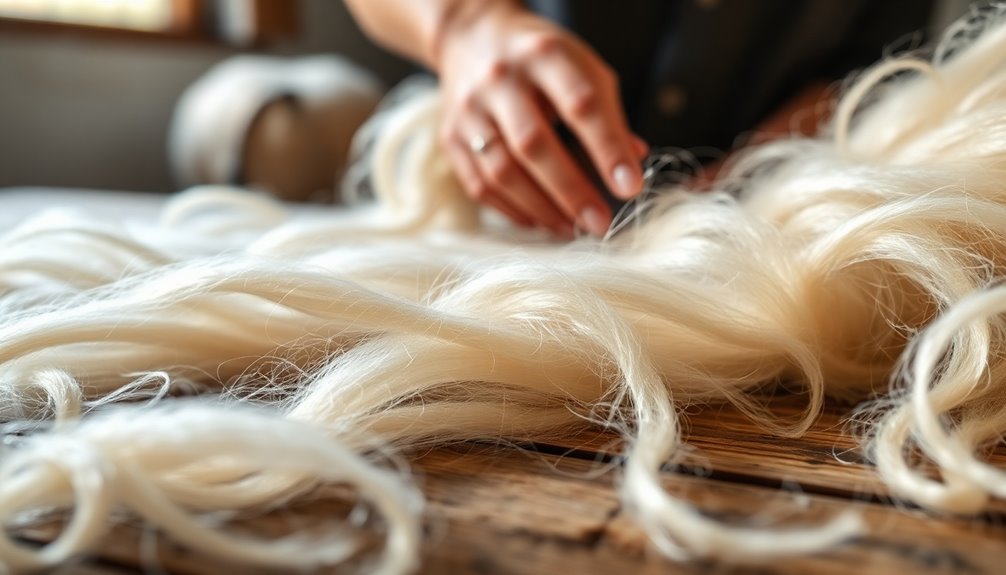
To appreciate the luxurious nature of mohair, it's vital to understand its production process, which begins with the careful shearing of Angora goats. Typically, these goats are sheared twice a year, with the finest fibers harvested in spring and autumn.
The production process involves several steps to guarantee the softness and luxury of the final product:
- Shearing: The fleece is collected, aiming for peak quality.
- Sorting and Washing: Impurities are removed, and fibers are prepared for spinning.
- Combing and Spinning: The long, lustrous strands are dyed and spun into yarn.
Sustainable practices are essential to minimize the environmental impact, as intensive farming can lead to soil degradation and loss of biodiversity.
The Benefits of Choosing Mohair
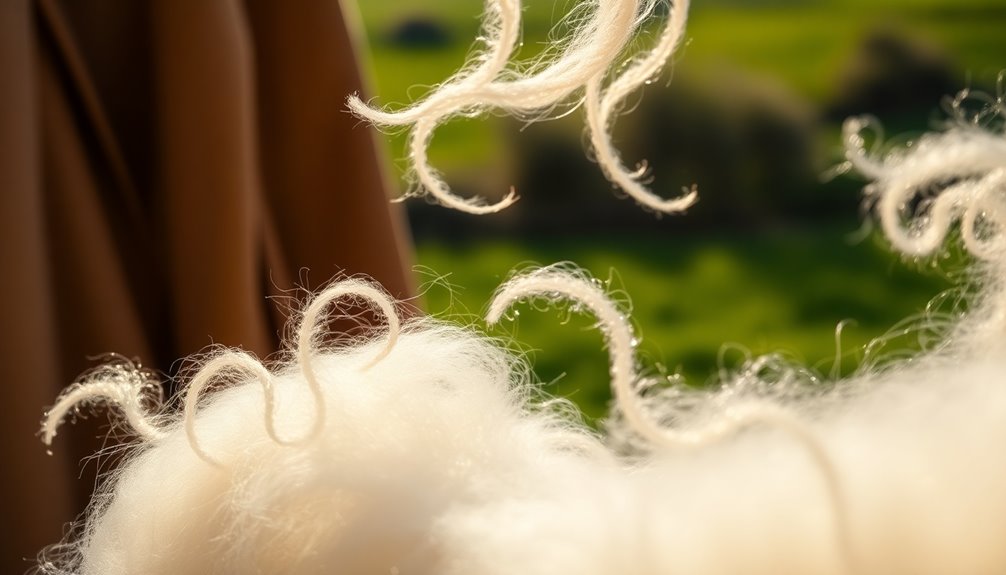
When you choose mohair, you're embracing luxurious softness that's gentler than traditional wool.
Plus, by opting for this fabric, you're supporting sustainable farming practices that benefit the environment.
It's a win-win for both your wardrobe and the planet!
Luxurious Softness Experience
Indulging in the luxurious softness of mohair transforms your wardrobe experience. This natural fiber offers a unique texture that elevates any outfit, making you feel both comfortable and stylish.
Here are three benefits of choosing mohair:
- Durability: Unlike cashmere, mohair resists wear, stretching, and shrinking, ensuring your garments last longer.
- Versatility: With its natural breathability, mohair keeps you warm in winter and cool in summer, perfect for year-round wear.
- Aesthetic Appeal: The silky feel and luxurious sheen of mohair enhance the overall look of your clothing, adding a touch of elegance.
Sustainable Farming Practices
The luxurious qualities of mohair not only enhance your wardrobe but also come from sustainable farming practices that benefit the environment.
Unlike cashmere, mohair farming has a lower environmental impact thanks to Angora goats' efficient grazing habits, which help prevent soil erosion. Mohair production uses the entire fleece with minimal waste, as farmers shear goats twice a year, guaranteeing resource efficiency.
This biodegradable and renewable fabric contributes to a circular economy when sourced from farms that prioritize sustainable methods and animal welfare. Responsible mohair farming supports biodiversity and maintains healthy ecosystems, while ethical practices guarantee goats are treated humanely.
Mohair Care and Maintenance Tips
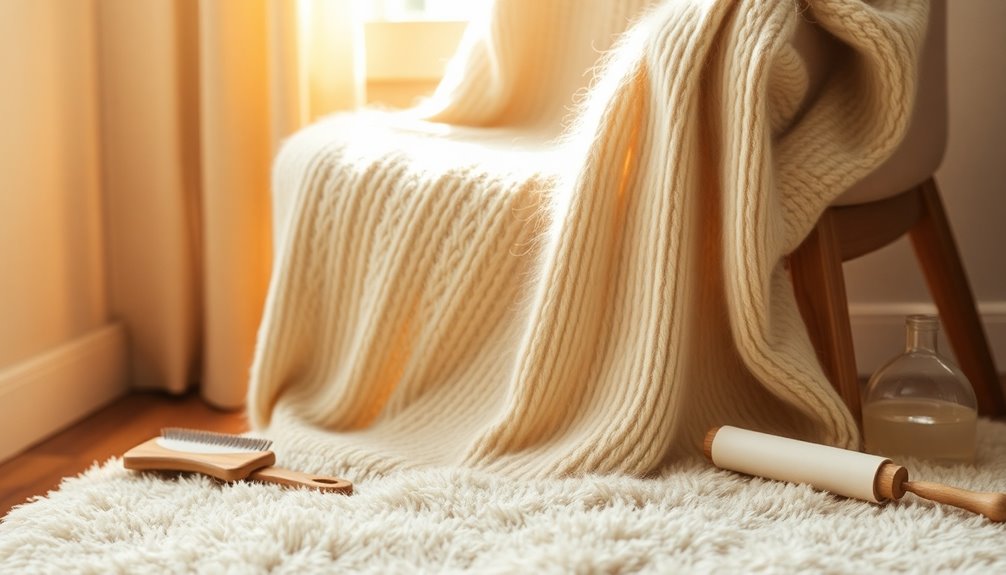
Caring for your mohair garments is essential to keep them looking luxurious and vibrant. To guarantee the softness and longevity of your mohair pieces, follow these maintenance tips:
- Hand Wash: Always hand-wash in cold water with a gentle detergent. Avoid machine washing, as it can damage the fibers.
- Dry Flat: Lay your mohair items flat to dry. Hanging them can distort their shape and lead to stretching.
- Proper Storage: Store mohair products in a cool, dry place. Avoid overcrowding in closets, and use breathable garment bags to prevent pilling.
For high-end items, consider occasional professional cleaning to preserve their luster.
When ironing, use a low heat setting and a cloth barrier to protect the delicate fibers.
Mohair in Fashion: Styling and Trends

As you explore the world of fashion, you'll find mohair standing out for its luxurious texture and versatility. This fiber's softness and sheen make it a favorite for elegant dresses and evening wear. Plus, its lightweight nature allows for easy layering, perfect for shifting seasons. Designers love to play with vibrant colors and intricate patterns, as mohair holds dye beautifully. Its natural elasticity guarantees tailored garments fit well and maintain their shape. The resurgence of mohair in both vintage and contemporary collections highlights its appeal as a sustainable luxury choice. Additionally, the increasing focus on sustainable fashion reflects consumers' desire for eco-friendly materials like mohair.
| Use Cases | Styling Tips | Trends |
|---|---|---|
| Evening Wear | Layer with denim | Vintage-inspired |
| Sweaters | Pair with skirts | Contemporary looks |
| Accessories | Mix with textures | Bold patterns |
| Tailored Pieces | Opt for structured fits | Bright color palettes |
| Casual Wear | Keep it relaxed | Sustainable fashion |
Sustainability and Ethical Considerations of Mohair

While mohair is celebrated for its luxurious qualities, its production raises important sustainability and ethical concerns. You should consider the following points:
- Environmental Impact: Mohair farming is resource-intensive, often leading to soil degradation and loss of biodiversity if not managed properly.
- Animal Welfare: Ethical dilemmas exist regarding the treatment of Angora goats, as some farms may not follow best practices for their care.
- Sustainable Sourcing: Opting for mohair from certified suppliers that prioritize ethical practices can greatly reduce its environmental footprint.
The growing demand for transparency in sourcing is encouraging more responsible farming methods.
The Future of Mohair in the Textile Industry
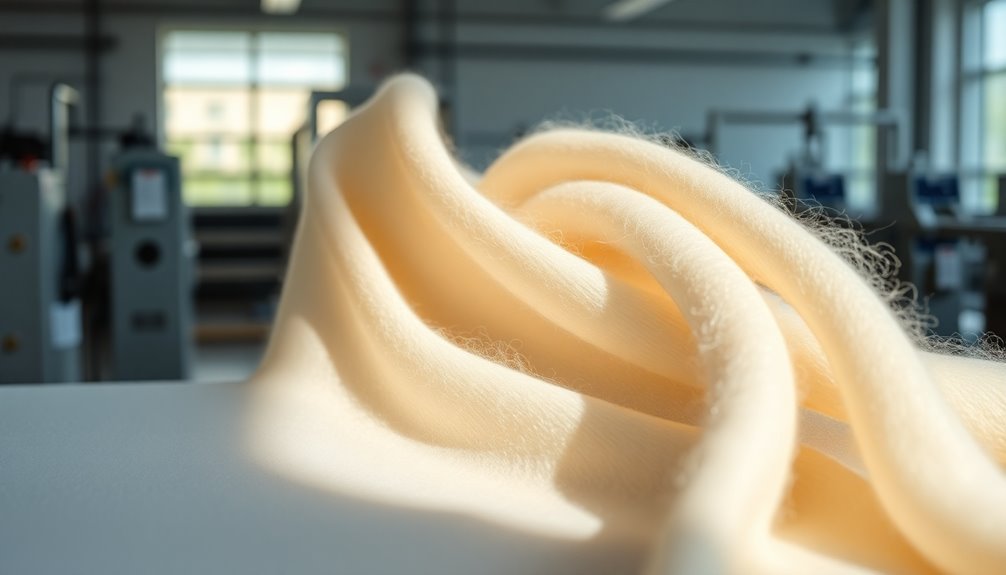
The future of mohair in the textile industry looks promising, driven by a surge in consumer demand for sustainable and ethically sourced fibers.
As eco-conscious brands rise, they're showcasing mohair's luxurious qualities while committing to environmentally friendly practices.
The global mohair market is projected to reach around $2.5 billion by 2025, hinting at substantial growth and innovation ahead.
Advances in farming techniques are set to improve production efficiency and minimize environmental impacts, addressing concerns about land and water usage.
Additionally, as awareness of animal welfare grows, the industry is adopting stricter ethical standards for Angora goats.
This shift will likely shape consumer choices, making mohair an increasingly popular option in sustainable fashion. Moreover, the integration of renewable energy technologies in mohair production can further enhance sustainability efforts within the industry.
Frequently Asked Questions
What Is Softer, Mohair or Cashmere?
When you compare softness, cashmere definitely takes the lead over mohair.
Cashmere fibers are finer, measuring between 12-16 microns, while mohair's fibers are thicker, ranging from 25-40 microns. This difference gives cashmere its incredibly soft, luxurious feel that many people prefer for clothing.
Although mohair has a lovely sheen and is durable, it just can't compete with the unparalleled softness of cashmere in high-end fabrics.
What Are the Disadvantages of Mohair?
When it comes to mohair, you might find yourself in hot water with its disadvantages.
While it's durable, it can lose softness over time without proper care. If you have sensitive skin, the coarse texture mightn't sit well with you, leading to discomfort.
Plus, mohair farming raises environmental concerns, requiring significant land and water, which can hurt sustainability.
In the end, it mightn't be the best choice for everyone.
Which Is More Expensive, Mohair or Cashmere?
When comparing prices, cashmere is generally more expensive than mohair.
You'll find high-quality cashmere garments costing between $100 and $500, while mohair typically ranges from $50 to $300.
The rarity of cashmere, sourced from cashmere goats, drives up its price, requiring multiple goats to produce enough for just one sweater.
In contrast, mohair comes from Angora goats and is produced in larger quantities, making it more accessible and affordable.
What Material Is Softer Than Cashmere?
Think of cashmere as a gentle cloud, but there are materials that float even softer.
Silk wraps you in smooth luxury, while baby alpaca fiber, with its whisper-like touch, rivals cashmere's softness.
Angora rabbit fur offers an incredibly plush feel, wrapping you like a warm hug.
Even blends of merino wool can surprise you with their silky texture, making them a delightful alternative for those seeking ultimate comfort and luxury.
Conclusion
In a world buzzing with fabric choices, mohair stands out like a shimmering star in the night sky. Its softness wraps around you like a warm embrace, offering both luxury and comfort. As you explore its unique qualities and sustainable future, you'll find that mohair isn't just a fabric; it's a lifestyle. So go ahead, indulge in this exquisite textile and let its elegance elevate your wardrobe to new heights. You'll never want to look back!
